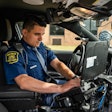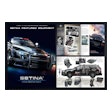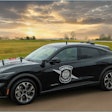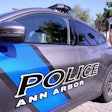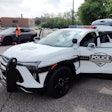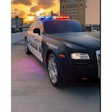Chevrolet Camaro
Our favorite traffic car returns for another year of duty, largely a carry-over from last year. The torquey LT1 V-8 received a lower-restriction exhaust for '96, good for a 10 bhp bump to 285 at 5,200 rpm, a figure unchanged this year.
ASR- Chevy- speak for acceleration slip regulation; we'd call it traction control- is optional and worthy of consideration by northern departments pondering four- season operation of the Camaro. ASR applies the brake to a spinning rear wheel and chops the power if need be, a technique that enables the optional Goodyear RSA footwear to effectively transfer power to the pavement, even in truly awful conditions.
The cockpit, as before, features cloth bucket seats with good lateral support, although the side bolster does rub on a holstered sidearm. Adjustability is good, thanks to a lower cushion that tilts, as does the seatback. A tilt steering wheel helps round out the driver- friendly ergonomics.
Handling is excellent, nearly neutral at the limit, due to the steamroller 50- series tires and 80 in -wide aluminum wheels that make full use of the nicely damped suspension. The accurate steering faithfully keeps the driver in touch with the road, permits razor- sharp turn-in and allows subtle correction in midcorner.
On a back-road tour from Denver to Phoenix and back, we spent two days hammering down mountain grades and diving deep into corners at upwards of twice the suggested limits without ever inducing fade from the big four-wheel discs.
It goes as well as it stops. Zero to 60 was reached in 6.1 seconds, 100 mph rolled past in 14.5 seconds and 140 mph was showing in less than a mile. Top speed: 151 mph. Now that the Caprice is gone and Ford has yet to offer the restyled Mustang for police work, there are no other domestic police vehicles in the same league with the Camaro. Sure, it's strictly a traffic unit, hefty officers don't fit it very well, and crawling into and out of the low Camaro all day long can be a nuisance. But all that's forgotten the first time you toe deep into the throttle and hear the throaty roar of a big American V-8 getting down to business. To us, that alone is worth the price of admission.
Ford Crown Victoria
For '97, the big Ford receives a re-engineered steering box with a new on-center detent to help stabilize the control valve and improve tracking. The box benefits from new low- friction bearings, a new sector shaft and sector cover, and machining improvements that reduce clearances and enhance steering precision.
Inside, cloth bucket seats remain standard issue, providing adequate comfort while allowing installation of a large, central equipment rack. Dual airbags and full instrumentation are standard. The Crown Victoria's superior ergonomics make the controls almost intuitive in nature and foster a sense of familiarity after only a short time behind the wheel.
Four- wheel discs with ABS are standard. Unfortunately, ABS and traction assist are unavailable if the limited- slip differential is ordered.
The sole powerplant is the Triton 4.6- liter SOHC V-8, which generates 210 bhp at 4,250 rpm and 275 lb-ft of torque at 3,250 rpm. Throttle tip-in is precise, overall response is excellent and the comparatively small- displacement engine feels stronger in the midrange than test numbers show. Despite its relatively high specific output, the 281 cubic-inch engine is coupled to a relatively tall 3.27:1 final drive and is asked to motivate nearly two tons worth of automobile. On the road, this translates into very modest low-speed acceleration, a trait that's highlighted by the electronic four-speed automatic's refusal to downshift to first gear except at very low road speeds.
Next year, the Crown Victoria squares off against the new Chevy Tahoe four-door police vehicle. Despite the SUV's extra 1,000 pounds, having tested the Tahoe, we predict a close match between the two. Power-to-weight ratios of the two are within a percentage point of each other and the Chevy benefits from much greater torque- 330 lb-ft at 2,800 rpm versus 275 lb-ft at 3,250 rpm- which, coupled to a stout 4.10:1 final drive, will enable it to accelerate father to 100 mph. The lighter Ford's .34 Cd aerodynamic drag- about 30 percent less than the Tahoe's- should see it pull ahead to reach a maximum in the neighborhood of 130 mph, 10 mph more than we expect to see from the more powerful Tahoe.
The Crown Victoria fulfills its mission with confidence, offering a well- sorted package of proven components. And with its NGV engine option, the big sedan can go about its mission squeaky clean, emitting a phenomenally low amount of pollutants. We like that combination: effective law enforcement and social responsibility in one package.
[PAGEBREAK]
Chevrolet Lumina
Front- drive police cars have never found much favor in this country. Credit this to less interior room, a smaller trunk, fuel mileage little better than the full-size units and a disturbing tendency to make pretzels of their halfshafts when bounced over curbs. But brand loyalty among Chevrolet's law enforcement customers is so strong that when the Caprice disappeared, many purchased Luminas last year rather than switch to Fords. This is no minor decision in view of the different handling characteristics and, well, more- retrained performance.
Ford no longer offers the Taurus police package, leaving the Lumina as the sole front-drive sedan available in police trim. Its 1.3 inches longer and 4.3 inches narrower than the Tahoe, offers 58 inches of front shoulder room and 57.4 inches of rear shoulder room compared to 65 inches front and rear for the sport utility vehicle. Officers accustomed to the sofa- like front shoulder room of the Caprice will notice the five fewer inches offered by the Lumina. Rear- seat legroom is almost identical, however.
MacPherson struts at each corner benefit from stiffer springs and tighter shock valving and are linked by fatter anti-roll bars. The combination does limit body roll and produces predictable handling, although heavy understeer is always on duty. Power is provided by a 3.1- liter pushrod V-6 generating 160 bhp at 5,200 prm and 185 lb-ft of torque at a lofty 4,000 rpm. The four-speed automatic cooperates by snapping off downshifts without delay when more grunt is called for, a frequent occurrence if you're in a hurry.
Stopping is capably handled by discs at each corner, and augmented by four-wheel ABS. The standard Goodyear Eagle GT+4 rubber offers up .79g of lateral grip without protect and helps produce 160- foot stopping distances from 60 mph. Steering is only average in feel but accurate enough to pick off apexes on demand.
The standard Recaro front bucket seats have drawn criticism from some drivers more accustomed to the overstuffed lounge chairs found in many sedans. But Recaro- equipped Lumina we suspect they'd notice the absence of the lower-back aches and pains common to lesser seats.
The Lumina isn't offered as a leading candidate for pursuit duties. Questioned about the matter, one Chevy fleet sales manager responded without hesitation, "If a guy runs on you, my advice: Get on the radio."
Not that its performance will subject the driver to total public humiliation; zero to 60 tolled by in 11 seconds, and the car saw 100 mph in 35 seconds. Top speed was an unremarkable 114 mph, a figure that can be expected to drop significantly if the bar is burdened by a high- drag light bar.
But a high top speed doesn't rank among the more important qualities sought by Lumina customers. They're shopping for reliability and value in a Chevrolet police car. We'd opine that the Lumina delivers.
Alternative: Clean- air vehicles
Ford is to be commended for making a natural gas- fueled 4.6- liter Triton V-8 available for police service last year. (Dedicated in this case means no dual- fuel operations like most alterative- fuel vehicles; the CNG Crown Victoria consumes only natural gas.) Under the hood, only the presence of a large pressure regulator suggests a requirement for natural gas; the stock engine's fuel rails are retained to sequentially inject compressed natural gas (CNG) rather than liquid fuel. Pistons from the DOHC 4.6 Triton engine raise compression one point to 10:1 and a different engine computer is installed.
Most of the NGV hardware is hidden from view, with two of the four cylindrical steel CNG tanks displacing the full-size spare tire at the forward part of the trunk. The other two tanks occupy the space normally filled by the stock gas tank.
So equipped, the NGV engine generates 175 bhp at 4,500 rpm, 35 fewer horsepower than the gas engine. Torque drops 40 lb-ft at 3,500 prm. Other than the lower power output, use of CNG does dictate some compromises. Trunk capacity is reduced to 14 cubic feet from 20.6, for example, and cruising range drops to the equivalent of 10 gallons of gas. And the CNG car offers only a 2.73:1 final drive, delivering less acceleration. In last year's Michigan State Police vehicle tests, such a unit achieved zero to 60 mph in 12.07 seconds (9.10 for the gas-motor version) and zero to 100 mph in 37.59 seconds, far off the pace of the gas motor's 25.18 seconds. Top speed is governed to 107 mph (132 mph for the gas motor).
We sampled a CNG-fueled Crown Vic and found it little different in behavior from the stock unit. The more- modest performance was evident, but the car otherwise acted just like its stablemate. Refueling is accomplished by coupling a high pressure adapter to a receptacle mounted in the stock fuel door, the opening a valve and activating the refueling pump. Found minutes later we were back on the road.
The CNG Crown Victoria is exceptionally clean- burning, emitting barely one-tenth the maximum emissions allowable under California's 1996 model-year standards. More significantly, it's fully 35 percent below the stringent federal Ultra Low Emissions Vehicle (ULEV) standards, likely making it the lowest emissions vehicle ever to be certified.
Law enforcement agencies in many municipalities large and small are being forced to buy and operate low-emission vehicles, a result of federal clean-air legislation. Although the NGV Crown Victoria is a compromise, the car itself is a well-sorted and proven performer in fleet service. Look for the more clean- burning police cars to appear from Ford and other manufacturers in the near future.
Craig Peterson is an automotive performance consultant to private industry and frquent contributor to POLICE.





